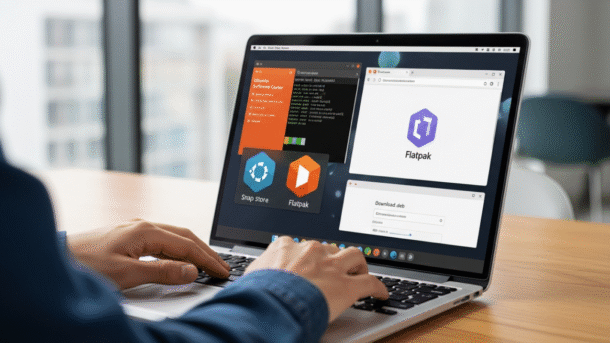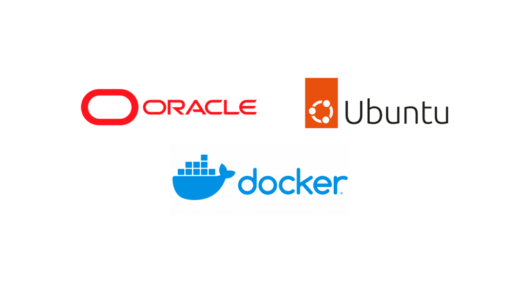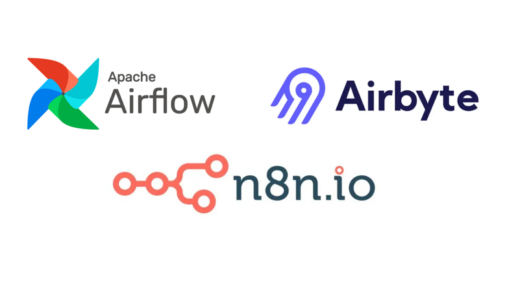Ubuntu offers several ways to install applications. Understanding each method helps you pick the right tool, avoid duplicates, and maintain a clean system. This guide covers six installation methods, includes Windows, iOS App Store, and Android Play Store analogies, plus terminal examples where relevant.
Table of Contents
- 1. Ubuntu App Center (Graphical Store)
- 2. APT (Ubuntu’s Package Manager)
- 3. DEB Packages (Manual Installation)
- 4. Snap Packages (Canonical’s Format)
- 5. Flatpak (with Flathub)
- 6. AppImage (Portable Executables)
- Summary Table
- Practical Recommendations
- Quick Decision Guide
- Avoiding Duplicates
- Final Thoughts
1. Ubuntu App Center (Graphical Store)
The App Center is simply the storefront, not a packaging format.
When to use it
- You want the simplest point-and-click experience
- You don’t care whether apps install as Snap, DEB, or Flatpak
- You’re new to Linux and prefer a familiar app store interface
Pros
- Easy to use
- Integrated updates
- Good for beginners
- Ubuntu 24.04+ includes Flatpak support
Cons
- Often installs Snap versions without warning
- Not always the latest builds
Windows Analogy
Ubuntu App Center ≈ Microsoft Store
Mobile Analogy
≈ App Store (iOS) or Play Store (Android) — a graphical front-end listing apps, regardless of how they’re packaged.
2. APT (Ubuntu’s Package Manager)
APT is Ubuntu’s primary command-line package manager. It installs DEB packages from official Ubuntu repositories and handles all dependencies automatically.
When to use it
- You’re following a tutorial that uses
aptcommands - You want system-integrated software with automatic dependency management
- You need command-line tools or development packages
- You want the most stable, tested versions
Pros
- Automatic dependency resolution
- Pulls from trusted Ubuntu repositories
- Fast and lightweight
- Easy updates with
sudo apt update && sudo apt upgrade - Most reliable method for system utilities
Cons
- Requires terminal/command line
- Sometimes has older versions than Snap or Flatpak
- Repositories might not include niche applications
Windows Analogy
APT ≈ Windows Package Manager (winget) — command-line installer from official repositories
Mobile Analogy
Installing from the official App Store/Play Store via command line (if that were possible)
Terminal Examples
Installing:
# Update package lists first sudo apt update # Install a package sudo apt install <package-name> # Search for packages apt search <keyword>
Upgrading:
# Update package lists sudo apt update # Upgrade a specific package sudo apt install --only-upgrade <package-name> # Upgrade all installed packages sudo apt upgrade # Full system upgrade (handles dependency changes) sudo apt full-upgrade
Uninstalling:
# Remove package but keep configuration files sudo apt remove <package-name> # Remove package and configuration files sudo apt purge <package-name> # Remove unused dependencies sudo apt autoremove
3. DEB Packages (Manual Installation)
DEB is the classic installer format used by Debian- and Ubuntu-based systems. You download a .deb file directly from a developer’s website and install it manually.
When to use it
- The developer provides an official
.debdownload on their website - The software isn’t available in Ubuntu repositories
- You want native performance
- You prefer non-containerized apps
Pros
- Fast and lightweight
- Uses system libraries
- Direct from the developer
Cons
- Updates require manual downloads (unless the DEB adds a repository)
- Can break if dependencies aren’t available
- Security risk if downloading from untrusted sources
Windows Analogy
DEB ≈ EXE installers — system-integrated, not containerized
Mobile Analogy
Closest equivalent: APK sideloading on Android (installing a standalone app package directly)
Where .deb files are stored
Usually in: ~/Downloads
Should you delete the .deb afterwards?
Yes. It’s only the installer.
Important Security Note
Only download .deb files from official developer websites or trusted sources. Verify checksums when provided.
Terminal Examples
Installing:
sudo dpkg -i file.deb
If you encounter dependency errors:
sudo apt --fix-broken install
Installing via GUI:
Double-click the .deb file in your file manager, and it will open in the App Center or Software Install tool.
Upgrading:
Manual DEB packages don’t auto-update. You need to:
- Download the new
.debfile from the developer’s website - Install it the same way (it will upgrade the existing version)
Some DEB packages add repositories during installation, enabling auto-updates via APT.
Uninstalling:
# Find the exact package name dpkg -l | grep <partial-name> # Remove the package sudo apt remove <package-name> # Or remove with configuration files sudo apt purge <package-name>
You can also uninstall via the App Center GUI.
4. Snap Packages (Canonical’s Format)
Snap is a packaging and sandboxing format used heavily by Ubuntu.
When to use it
- The app is officially distributed as Snap
- You want auto-updates
- You need an isolated/sandboxed application
Pros
- Safe (sandboxed)
- Auto-updates
- Easy rollback to previous versions
- Cross-distro compatibility
Cons
- Often slower to launch
- Larger disk footprint
- Some file system access limitations due to sandboxing
Windows Analogy
Snap ≈ MSIX (self-contained, auto-updating, sandboxed)
Mobile Analogy
Similar to how iOS/Android install apps with bundled dependencies, ensuring consistent behavior across devices.
Terminal Examples
Installing:
sudo snap install <package>
Upgrading:
# Snaps auto-update by default, but you can manually update sudo snap refresh <package> # Update all snaps sudo snap refresh # Check for available updates snap refresh --list
Uninstalling:
sudo snap remove <package> # Remove a snap and its saved data sudo snap remove --purge <package>
Listing installed:
snap list
5. Flatpak (with Flathub)
Flatpak is a cross-distro packaging system that competes with Snap.
When to use it
- You want the newest versions
- You want apps isolated from system dependencies
- You prefer Flathub’s large catalog
- The app isn’t available via APT or Snap
Pros
- Updated frequently
- Huge catalog on Flathub
- Works across almost all Linux distros
- Good sandboxing
Cons
- May require adding Flathub manually (on older Ubuntu versions)
- Larger disk usage than DEB
- Can have similar startup delays as Snap
Windows Analogy
Flatpak ≈ MSIX packages distributed outside the Microsoft Store
Mobile Analogy
Equivalent to enabling a trusted external app repository, similar to:
- Adding TestFlight sources (iOS, conceptually)
- Adding external stores like F-Droid (Android)
Terminal Examples
One-time setup (if Flathub not already configured):
sudo flatpak remote-add --if-not-exists flathub https://flathub.org/repo/flathub.flatpakrepo
Installing:
# Install an app flatpak install flathub md.obsidian.Obsidian # Search for apps flatpak search <keyword>
Upgrading:
# Update a specific app flatpak update md.obsidian.Obsidian # Update all Flatpak apps flatpak update # Check for available updates flatpak remote-ls --updates
Uninstalling:
# Remove an app flatpak uninstall md.obsidian.Obsidian # Remove unused runtimes and dependencies flatpak uninstall --unused
Running and listing:
# Run an app flatpak run md.obsidian.Obsidian # List installed apps flatpak list
Note: Ubuntu 24.04+ includes Flatpak support in the App Center, so you can install, update, and remove Flatpak apps graphically without terminal commands.
6. AppImage (Portable Executables)
AppImage is a single-file portable app that requires no installation.
When to use it
- You want a fully portable app
- You don’t want changes to your system
- You want to try beta versions safely
- You need multiple versions of the same app
Pros
- No installation required
- No dependencies
- Works across most Linux distros
- Fully portable (can run from USB drive)
Cons
- No automatic updates
- Not added to the app menu automatically
- No centralized management
Windows Analogy
AppImage ≈ portable ZIP folder containing a portable EXE
Mobile Analogy
There is no iOS equivalent (iOS doesn’t allow portable apps).
Closest Android comparison: running a standalone APK extracted from a ZIP, but even that isn’t truly portable.
Where AppImages are stored
Usually downloaded to: ~/Downloads
Users often move them to custom folders like:
~/Applications~/AppImages
(you create these folders manually)
Should you delete the AppImage?
No. The file is the app.
Integrating AppImages into your app menu
Consider using AppImageLauncher, which automatically integrates AppImages into your system menu.
Note: The PPA is deprecated. Instead, download the .deb package directly:
- Visit the AppImageLauncher releases page
- Download the appropriate
.debfile for your system (usuallyamd64for most computers) - Install it:
cd ~/Downloads sudo dpkg -i appimagelauncher_*.deb
If you encounter dependency errors, run:
sudo apt install -f
How AppImageLauncher works:
AppImageLauncher is not an app you open directly – it’s a background helper that automatically activates when you interact with AppImage files.
When you download an AppImage and double-click it (or try to run it), AppImageLauncher will intercept it and show a dialog asking:
- “Do you want to integrate this AppImage into your system?”
- Options to integrate it (moves it to
~/Applicationsand adds it to your app menu) or just run it once
To verify it’s installed:
which AppImageLauncher # Should show: /usr/bin/AppImageLauncher
To see integrated AppImages:
ls ~/Applications
Note: The ~/Applications folder is created automatically the first time you integrate an AppImage. If you haven’t integrated any AppImages yet, this folder won’t exist.
Alternative: AppImageLauncher Lite
If you prefer not to install system-wide, try AppImageLauncher Lite, which is an AppImage itself and doesn’t require root access:
- Download
appimagelauncher-lite*.AppImagefrom the releases page - Make it executable:
chmod +x appimagelauncher-lite*.AppImage - Run:
./appimagelauncher-lite*.AppImage install
Important: Installing FUSE (Required for AppImages)
AppImages require FUSE (Filesystem in Userspace) to run. On newer Ubuntu versions, you may need to install it manually:
sudo apt install libfuse2
Common error without FUSE:
dlopen(): error loading libfuse.so.2 AppImages require FUSE to run.
If you see this error, install libfuse2 as shown above.
Terminal Examples
Installing/Running:
Make it executable (first time only):
chmod +x MyApp.AppImage
Run it:
./MyApp.AppImage
If you get a FUSE error:
sudo apt install libfuse2
Upgrading:
AppImages don’t auto-update. To upgrade:
- Download the new version from the developer’s website
- Delete or rename the old AppImage
- Make the new one executable and run it
Some AppImages have built-in update checkers that will notify you.
Uninstalling:
Simply delete the AppImage file:
rm ~/Applications/MyApp.AppImage
If you used AppImageLauncher, right-click the app in your menu and select “Remove”.
Summary Table
| Method | Ubuntu Concept | Windows Analogy | iOS/Android Analogy | Best For |
|---|---|---|---|---|
| App Center | Storefront | Microsoft Store | App Store / Play Store | Beginners, GUI users |
| APT | System package manager | winget | Official store CLI | System tools, CLI users |
| DEB (manual) | Native installer | EXE installer | APK sideload | Developer downloads |
| Snap | Modern sandboxed apps | MSIX | Standard mobile app | Auto-updating apps |
| Flatpak | Universal sandboxed apps | External MSIX | F-Droid / external repos | Latest versions |
| AppImage | Portable executable | Portable ZIP + EXE | No real equivalent | Portable apps, testing |
Practical Recommendations
For complete beginners:
- Start with App Center for most apps
- Learn APT for following tutorials and installing development tools
For daily desktop apps:
- Flatpak (Flathub) for the latest versions
- APT for system utilities and command-line tools
For official developer downloads:
- DEB packages from trusted sources
For portable/testing apps:
- AppImage when you need something temporary or portable
For Snap:
- Only use if no alternative exists, or if the app’s official distribution is Snap-only
Quick Decision Guide
“I want to install Firefox/LibreOffice/GIMP”
→ Use App Center or APT
“I’m following a tutorial that says sudo apt install“
→ Use APT in the terminal
“I need the absolute latest version of OBS Studio”
→ Use Flatpak from Flathub
“The developer’s website has a .deb download”
→ Download the DEB and install it
“I want to test beta software without affecting my system”
→ Use AppImage
“I need multiple versions of the same app”
→ Use AppImage or Flatpak
Avoiding Duplicates
You can have the same app installed multiple ways simultaneously (e.g., Firefox as both a Snap and DEB). To avoid confusion:
Check what’s installed:
# List APT packages dpkg -l | grep <package-name> # List Snaps snap list # List Flatpaks flatpak list # Check for AppImages ls ~/Applications ~/AppImages
Remove duplicates by uninstalling the versions you don’t want using the appropriate method.
Final Thoughts
Ubuntu’s flexibility in installation methods can seem overwhelming at first, but each serves a specific purpose. Start with the App Center and APT for everyday needs, then explore Flatpak and AppImages as you become more comfortable. Understanding these options will help you maintain a cleaner, more organized system.
Happy installing!





